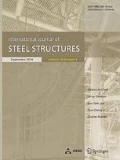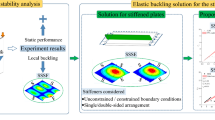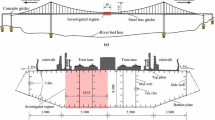Abstract
In this paper, the moment of inertia requirement of flat-bar longitudinal stiffener of bottom flange in steel box girder is investigated through finite element modeling. The required minimum stiffness for longitudinal stiffeners of box girder flange is given in the AASHTO LRFD Bridge Design Specification and is modified by Yoo. However, this requirement is adopted for T-shape stiffeners. Here, the effect of important parameters on the minimum required moment of inertia of flat-bar stiffener is numerically investigated by examining the anti-symmetric mode of buckling. This study presents the results that are based on 3D finite-element analysis of four hundred hypothetical compression flange models stiffened by varying numbers of flat-bar longitudinal stiffeners with realistic dimensions such as the height of stiffener, the thickness of the compression flange, the number of longitudinal stiffeners and the aspect ratio of plate panel. A new proposed equation for required minimum stiffness of the flat-bar longitudinal stiffeners is derived from nonlinear regression analyses. Beside that the study has taken into account the effect of boundary conditions and the effect of inelastic transition on the critical buckling stress of compression flange. Through the evaluation of a design example, the validity and reliability of the new proposed equation is demonstrated.
Similar content being viewed by others
References
American Association of State Highway Transportation Officials, (2008). “AASHTO LRFD Bridge Design Specifications, Customary, U.S. Units, Fourth edition, 2008 Interim Revisions.” Washington DC.
Alinia, M. M. (2005). “A study into optimization of stiffeners in plates subjected to shear loading.” Thin-Walled Structures, 43(5), pp. 845–860.
ANSYS (2004). “ANSYS Release 9.0 Documentation”. SAS IP, Inc.
Bridge Welding Code (2008). AASHTO/AWS D1.5-2008, A Joint Publication of American Association of State Highway and Transportation Officials, Inc. Washington, D.C. and American Welding Society, Miami, F.L., USA.
Carlsen, C. A. (1980). “A parametric study of collapse of stiffened plates in compression.” The Structural Engineer, 58B(2), pp. 33–40.
Clinton, H., Joehnk, G., and Petzold, E., (1986). “Design examples or steel box girders.” Rep. No. FHWA-TS-86-209, Federal Highway Administration, Washington, D.C.
Galambos, T. V. (1998). Structural stability research council guide to stability design criteria for metal structures-Fifth edition, John Wiley & Sons, Inc., New York.
Grondin, G. Y., Chen, Q., Elwi, A. E., and Cheng, J. J. R. (1998). “Stiffened steel plates under compression and bending.” Journal of Constructional Steel Research, 45(2), pp. 125–148.
Grondin, G. Y., Elwi, A. E., and Cheng, J. J. R. (1999). “Buckling of stiffened steel plates-a parametric study.” Journal of Constructional Steel Research, 50(2), pp. 151–175.
Faulkner, D. A. (1975). “Review of effective plating for use in the analysis of stiffened plating in bending and compression.” Journal of Ship Research, 9(1), pp. 1–17.
Kulicki J. M., Wassef W. G., Smith C., and Johns K. (2005). “AASHTO-LRFD design example horizontally curved steel box girder bridge.” Project No. NCHRP 12-52, National Cooperative Highway Research Program, Pennsylvania, USA.
Mancecorea website (2007). “The method of improving stiffness at the inner support in the steel box girder.” viewed: July 10, 2007, On-line version at http://mansecorea.com/english/00-manse2.html.
Mittelstedt, C. (2008). “Explicit analysis and design equations for buckling loads and minimum stiffener requirements of orthotropic and isotropic plates under compressive load braced by longitudinal stiffeners.” Thin-Walled Structures, 46(12), pp. 1409–1429.
Salmon, C. G. and Johnson, J. E. (1996). Steel structures-Design and behavior-Emphasizing load and resistance factor design-Fourth edition, HarperCollins, New York, NY.
Sharp, M. L. (1966). “Longitudinal stiffeners for compression members.” ASCE J. Struct. Div., 92(ST5), pp. 187–212.
Sheikh, I. A., Grondin, G. Y., and Elwi, A. E. (2002). “Stiffened steel plates under uniaxial compression.” Journal of Constructional Steel Research, 58(5-8), pp. 1061–1080.
Timoshenko, S. P. and Gere, J. M. (1961). Theory of elastic stability-Second edition, McGraw-Hill Book Co., Inc., New York, N.Y., USA.
Yoo, C. H. (2001). “Design of longitudinal stiffeners on box girder flanges.” International Journal of Steel Structures, 1(1), pp. 15–23.
Yoo, C. H., Choi, B. H., and Ford, E. M. (2001). “Stiffness Requirements for Longitudinally Stiffened Box-girder Flanges.” Journal of Structural Engineering, 127(6), pp. 706–711.
Author information
Authors and Affiliations
Corresponding author
Rights and permissions
About this article
Cite this article
Thang, D.D., Koo, MS., Hameed, A. et al. Stiffness requirement for flat-bar longitudinal stiffener of box-girder compression flanges. Int J Steel Struct 9, 115–122 (2009). https://doi.org/10.1007/BF03249486
Received:
Accepted:
Issue Date:
DOI: https://doi.org/10.1007/BF03249486




